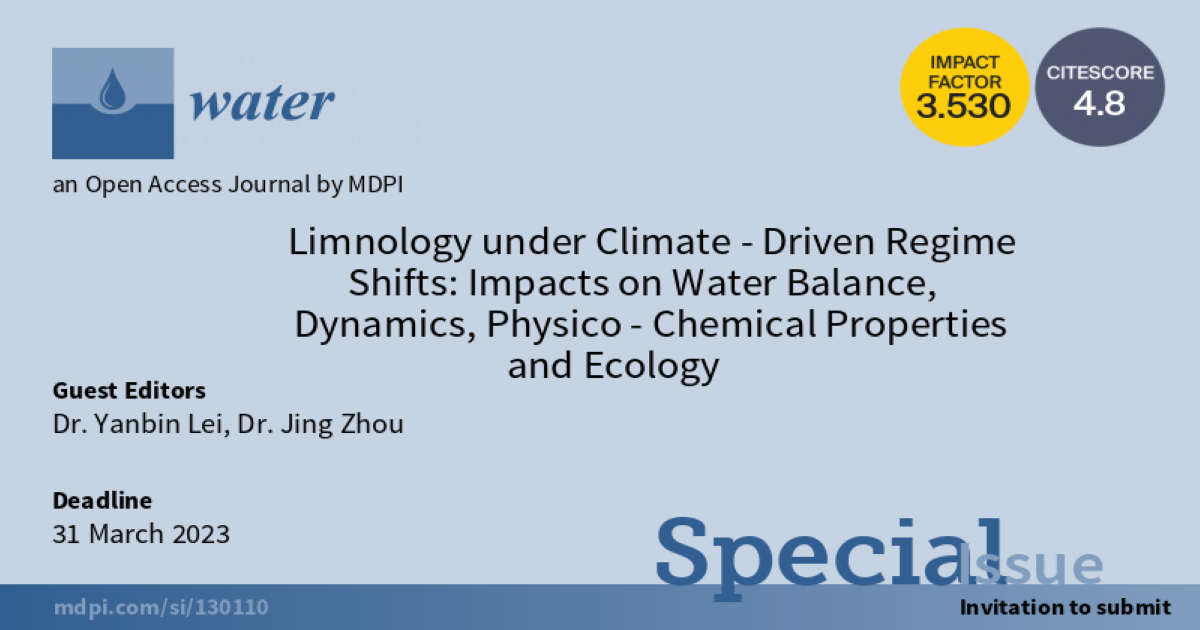Limnology under Climate-Driven Regime Shifts: Impacts on Water Balance, Dynamics, Physico-Chemical Properties and Ecology
A special issue of Water (ISSN 2073-4441). This special issue belongs to the section "Hydrology".
Deadline for manuscript submissions: closed (31 March 2023) | Viewed by 2466

Special Issue Editors
Interests: lake dynamics and climate change; lake hydrology
Special Issues, Collections and Topics in MDPI journals
Special Issue Information
Dear Colleagues,
We are pleased to announce the new Special Issue of Water entitled ‘Limnology under Climate-Driven Regime Shifts: Impacts on Water Balance, Dynamics and Physico-Chemical Properties’. Lakes not only play an important role in the global hydrological and biogeochemical cycle but also serve as important water resources including drinking water supply, agricultural production, recreation and fisheries. Based on in situ observation, satellite data and modeling, significant changes in lake physical conditions have been investigated during the past decades, including loss of ice cover, rising surface water temperature, changes in evaporation and water budgets, and alteration of mixing regimes, etc.
While our understanding of physical lake response to global climate change has improved in recent decades, only a small portion of lakes have been investigated in detail. More research about changes in lake conditions is still needed, especially for lakes in remote areas where there is a lack of in situ observations. Therefore, this Special Issue main focuses on the response of lake physical-chemical conditions to climate change in different regions of the world, mainly in terms of changes in the lake area, water level and water storage, lake ice phenology, water temperature, mixing regimes, evaporation, and water quality, etc.
We are looking forward to your participation and submission.
Dr. Yanbin Lei
Dr. Jing Zhou
Guest Editors
Manuscript Submission Information
Manuscripts should be submitted online at www.mdpi.com by registering and logging in to this website. Once you are registered, click here to go to the submission form. Manuscripts can be submitted until the deadline. All submissions that pass pre-check are peer-reviewed. Accepted papers will be published continuously in the journal (as soon as accepted) and will be listed together on the special issue website. Research articles, review articles as well as short communications are invited. For planned papers, a title and short abstract (about 100 words) can be sent to the Editorial Office for announcement on this website.
Submitted manuscripts should not have been published previously, nor be under consideration for publication elsewhere (except conference proceedings papers). All manuscripts are thoroughly refereed through a single-blind peer-review process. A guide for authors and other relevant information for submission of manuscripts is available on the Instructions for Authors page. Water is an international peer-reviewed open access semimonthly journal published by MDPI.
Please visit the Instructions for Authors page before submitting a manuscript. The Article Processing Charge (APC) for publication in this open access journal is 2600 CHF (Swiss Francs). Submitted papers should be well formatted and use good English. Authors may use MDPI's English editing service prior to publication or during author revisions.
Keywords
- lake level and extent
- lake water storage
- lake water budget
- lake water temperature
- lake mixing regimes
- lake ice phenology
- lake evaporation
- lake water clarity
- lake water quality





